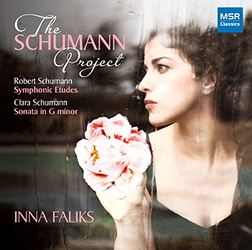INNA FALIKSAlso Available
 LISTEN
REVIEWS
"Inna Faliks is a passionately committed artist who has made a name for herself through poetic and commanding performances... Faliks gives a warm and expressive operformance of [Clara's Sonata]... Faliks plays this dramatic, powerful music here with trmendous verve and sensitivity, revealing both her mastery of the piano and deep understanding of [Robert Schumann's ] work... highly reccomended."John Pitt, New Classics [September 2021]"I am...impressed with [Faliks] on this new release... The Symphonic Etudes are given a lively and expressive performance that I would have been happy to add to the 13 that I have already in my collection. I listened to one by Alfred Brendel (Philips) for a direct comparison that Faliks survived easily."Repp, American Record Guide [September/October 2021]"By juxtaposing two large-scale Schumann works, Faliks demonstrates the stylistic and character differences between the two composers very clearly, while espousing a lyrical reading of both works. Clara's Piano Sonata in G Minor is characterized by Faliks' sweetness of sound and elegance of temperament. She achieves a remarkable legato in lyrical passages, and a consistently warm and generous sound, even in energetic sections. By contrast, her approach to Robert's Symphonic Etudes is just that—symphonic; she coaxes a tremendous range of color and articulation from the instrument, giving each etude a specific sound world to inhabit, from the most playful to the most furious. Especially impressive is the handling of the notorious Etude IV, in which she shapes each arpeggiation very subtly in accordance with the harmonic progression and shape of each phrase. The finale showcases the dynamic power of the instrument, and Faliks produces a massive sound while retaining its fundamental warmth, giving a true sense of joy to the end of the journey."Scott Cuellar, Clavier Companion / Piano Magazine [September 2021]"Volume 1 of the Schumann Project presents a smooth, interesting performance of Clara’s Sonata in G minor, followed by a warm reading of Robert’s Symphonic Etudes, a work of dazzling richness and opportunity for pianists to reveal the full range of their interpretative skill.... [Faliks] offers us a Clara Schumann still filled with dreams and delicacy. It is a subtle performance, with airiness lightly whipped into the presentation... In the fourth movement, Faliks produces soft, plump tones, fully hydrated but resilient to her steady touch. [In Robert’s Etudes] Faliks takes a gentle approach to this varied array of musical miniatures. This is Schumann the mild, a fitting partner for the dreamy sonata which opens the album, romanticism with a wistful flair, not wildly tearing up the keys as one often hears in performances of works from this era... [Faliks] is an insightful and skilled musician with an original point of view, and I look forward to her next volume as the Schumann saga continues to unfold."Linda Holt, ConcertoNet [June 2021]"Captivating poetics, unforced and flowing, emanate from the hands of pianist Inna Faliks while she shares her renderings of works by Clara and Robert Schumann... each of the works reveals their talents and may well become part of one’s music listening repertoire, especially as Faliks masterfully plays them."Joel C. Thompson, Cherry Grove Music Review [May 2021]"Faliks is in a league with some of the greatest pianists to record [these works]. She does face formidable competition from greats like Richter, Kempff, Gilels, and Ashkenazy, to name a few. That her album concept is unique and her exceptional pianism backs it up is all the reason you need to add this to your library. With the superb recorded sound of her Yamaha DCFX and high production values all around, I am certain to be on the lookout for all future volumes in this series."James Harrington, Fanfare"Inna Faliks offers attentive, nuanced and beautifully balanced readings of major works by both Schumanns, Robert and Clara, on a CD titled “The Schumann Project, Volume 1” – implying that there are more such juxtapositions to come. They will be most welcome if they continue in the same vein as this initial disc... There will surely be [obscure-but-fascinating biographical connections] as Faliks continues juxtaposing works by Robert and Clara – and hopefully playing them with as much understanding and skill as she brings to these two."Mark J. Estren, InfoDad [May 2021]"Pianist Inna Faliks performs the [Clara Schumann] Sonata with devotion and energy.... Faliks addresses the opening motif [of Robert Schumann's Symphonic Etudes] with a stentorian, orchestral sonority."[ * * * * ] Gary Lemco, Audiophile Audition [March 2021]"Once again, Ukrainian-American pianist Inna Faliks scores high marks, [this time] in Vol.1 of her project honoring Robert and Clara Schumann. The outlook is good for this continuing series, given Ms. Faliks’ high degree of professional commitment and inspired pianism... Faliks meets this challenge admirably, using her own impressive technique and sense of proportion to position them for optimal effect. The result is often very moving... Faliks knows just where to place the emphasis."Phil Muse, Atlanta Audio Club [Spring 2021]PROGRAM NOTES
Watch Inna Faliks perform HERE. THE SCHUMANN PROJECT | VOLUME 1 Juxtaposing two large scale works by Clara Schumann (née Wieck) and Robert Schumann on a recording will certainly invite comparisons between them; however, my aim in The Schumann Project series is to simply unite, on each album, two or more works by kindred souls. How different the dynamics of this “power couple” of the 19th century might be today if one were to imagine Robert and Clara as equal partners in life. Robert’s endlessly rich, phantasmagorical compositional world thrived with a muse like Clara. Robert surely respected Clara the concert pianist and didn’t necessarily discourage Clara the composer. But Clara the concert pianist, mother, wife and caretaker to her troubled, unstable husband outweighed Clara the composer – so much so that her confidence in her own compositional skill simply had no room to blossom. Offering Robert’s and Clara’s music together on the same program is not only a tribute to their musical voices but also to love and partnership in its many forms and with all its complexities, pains and joys. My experience with Robert and Clara Schumann began when I was 15 years old, and was asked to perform Clara Schumann’s Piano Concerto in A minor (composed when she was 15) with the Chicago Symphony Orchestra. Around the same time, my teacher in Chicago, Emilio del Rosario, was preparing Robert Schumann’s Carnaval at the Music Institute of Chicago. As he worked on it, I heard the piece’s magical characters emerge from his studio, day after day. I became obsessed with the most unpredictable, whimsical, hearton-the-sleeve musical language I had ever encountered. I had to learn this piece and this language! The obsession never left me, and since then many of Robert Schumann’s large scale piano works became staples of my repertoire. But only in recent years have I begun to rediscover Clara’s piano music. Last spring, my students at UCLA performed her works for piano in their entirety. Shortly thereafter, I decided to embark on a journey I had always planned, recording much of Robert’s music, but together with Clara’s. Her compositional voice, while perhaps not developed to its full extent, speaks with individuality and brilliance. On one hand, I never want to leave Robert’s imaginary world of literary references, unfulfilled yearnings, hidden riddles, grand gestures and lyrical intimations. For me, no other composer of his time speaks as unguardedly and unabashedly from the heart, giving performers great opportunity for fantasy, interpretive freedom and the most intimate kind of communication. On the other hand, Clara was an inseparable part of his world and his music, quite literally – Robert quoted her often, at times without credit. In turn, her voice, with its meandering, uncomfortable chromaticism, unpredictable harmonic turns, stormy gestures and profound tenderness, is like no other. “I had once believed I had creative talent, but I have given up this idea; a woman must not wish to compose – there was never one able to do it. Am I intended to be the one?” she wrote in her diary. Her husband, presumably, never answered clearly. Ukrainian-born American pianist Inna Faliks is a passionately committed artist who has made a name for herself through her poetic and commanding performances of standard piano repertoire, genre-bending interdisciplinary projects and inquisitive work with contemporary composers. After her acclaimed teenage debuts at the Gilmore Festival and with the Chicago Symphony, she has performed on many of the world’s great stages, with numerous orchestras, in solo appearances and in highly regarded chamber music partnerships. Highlights of recent seasons include critically acclaimed performances at the Ravinia Festival and the National Gallery in Washington, D.C., Chigiana Academy in Siena, Festival Intenacional de Piano in Mexico, Fazioli Series in Italy, Tel Aviv Museum, Portland Piano Festival, Camerata Pacifica, Broad Stage Santa Monica, Jacaranda, Wallis Annenberg subscription series in Los Angeles and recital tours of China, with appearances in major halls, such as Beijing Center for Performing Arts and Shanghai Oriental Arts Theater. Other major venues include Weill Hall, Met Museum, Salle Cortot, Symphony Center, Tchaikovsky Hall and at festivals, including Verbier, Brevard, International Keyboard Festival in New York, Bargemusic’s Here and Now, Chautauqua and Newport. She is also in demand as a concerto soloist. A prolific recording artist, Faliks has been featured on WQXR, WNYC, WFMT radio and in many international television broadcasts. Faliks is the founder and curator of the of the poetry-music series Music/Words, creating performances in collaboration with distinguished poets, including as Vera Pavlova and Jesse Ball. Faliks also tours regularly with her autobiographical recitalmonologue, Polonaise-Fantasie, the Story of a Pianist throughout the United States, Canada and Europe, and co-starred with Downton Abbey star Lesley Nicol in Admission – One Shilling about the life of the great British pianist, Dame Myra Hess. Many of today’s leading composers have composed works for her, including Richard Danielpour, Billy Childs, Paola Prestini and Clarice Assad. She has received awards at numerous prestigious competitions, including Hilton Head International Piano Competition and International Pro Musicis Award. In March 2019, Faliks was Artistic Director of Classical Music for YoungArts LA, and has written for The Los Angeles Times and The Washington Post. Currently Professor of Piano and Head of Piano at UCLA, Faliks is internationally in demand as an Artist Teacher and master class artist. Inna Faliks is a Yamaha Artist. [ www.innafaliks.com ] PROGRAM
CLARA SCHUMANN (1819-1896)PIANO SONATA IN G MINOR (1841) I. Allegro II. Adagio - con espressione e ben legato III. Scherzo – leggieramente IV. Rondo ROBERT SCHUMANN (1810-1856) SYMPHONIC ETUDES, OP.13 (1834) I. Theme II. Etude I (Variation 1) – Un poco più vivo III. Etude II (Variation 2) – Andante IV. Etude III – Vivace V. Posthumous Variation I VI. Posthumous Variation II VII. Etude IV (Variation 3) – Allegro marcato VIII. Etude V (Variation 4) – Scherzando IX. Posthumous Variation III X. Etude VI (Variation 5) – Agitato XI. Etude VII (Variation 6) – Allegro molto XII. Etude VIII (Variation 7) – Sempre marcatissimo XIII. Posthumous Variation IV XIV. Etude IX – Presto possibile XV. Etude X (Variation 8) – Allegro con energia XVI. Etude XI (Variation 9) – Andante espressivo XVII. Posthumous Variation V XVIII. Etude XII (Finale) – Allegro brillante MSR Classics |


